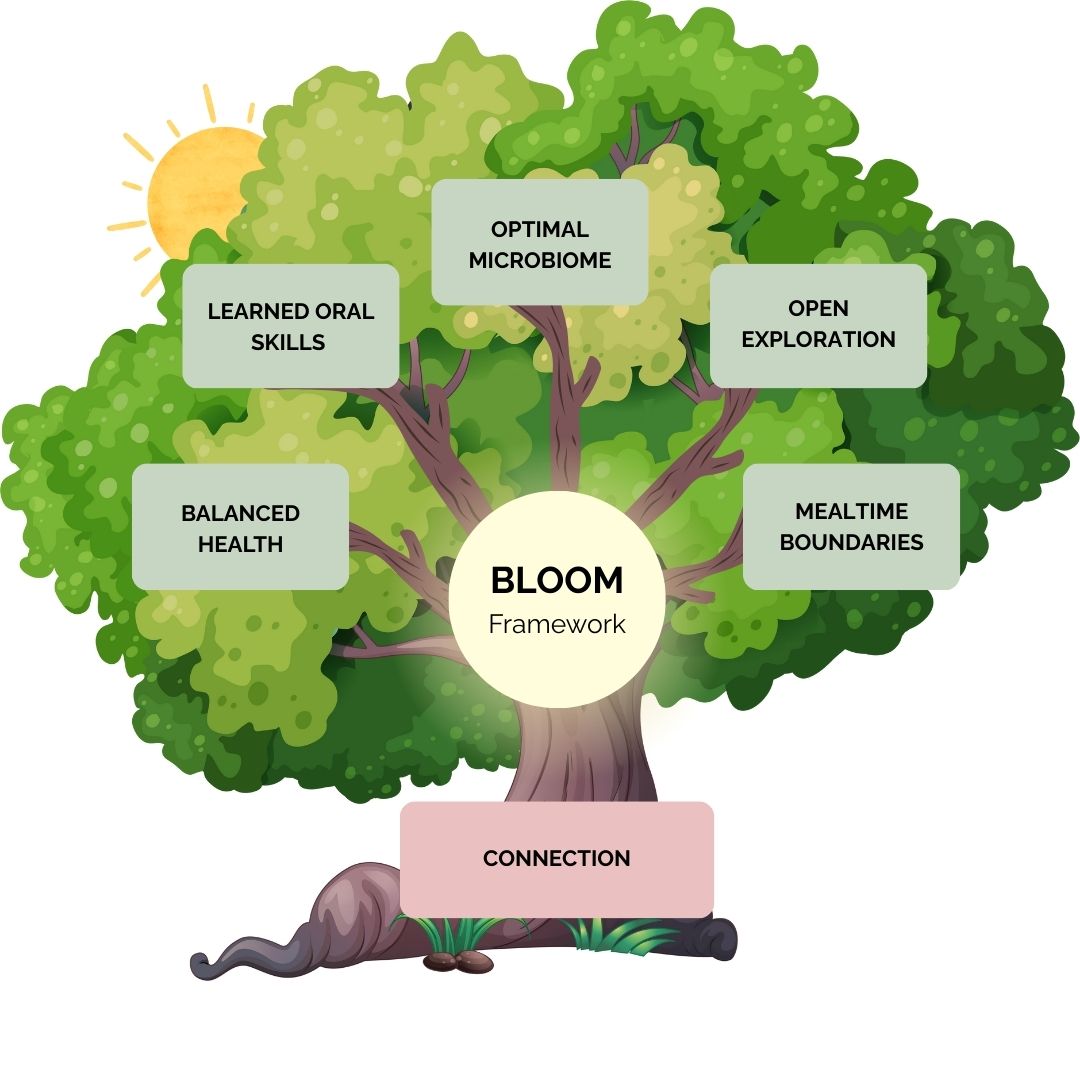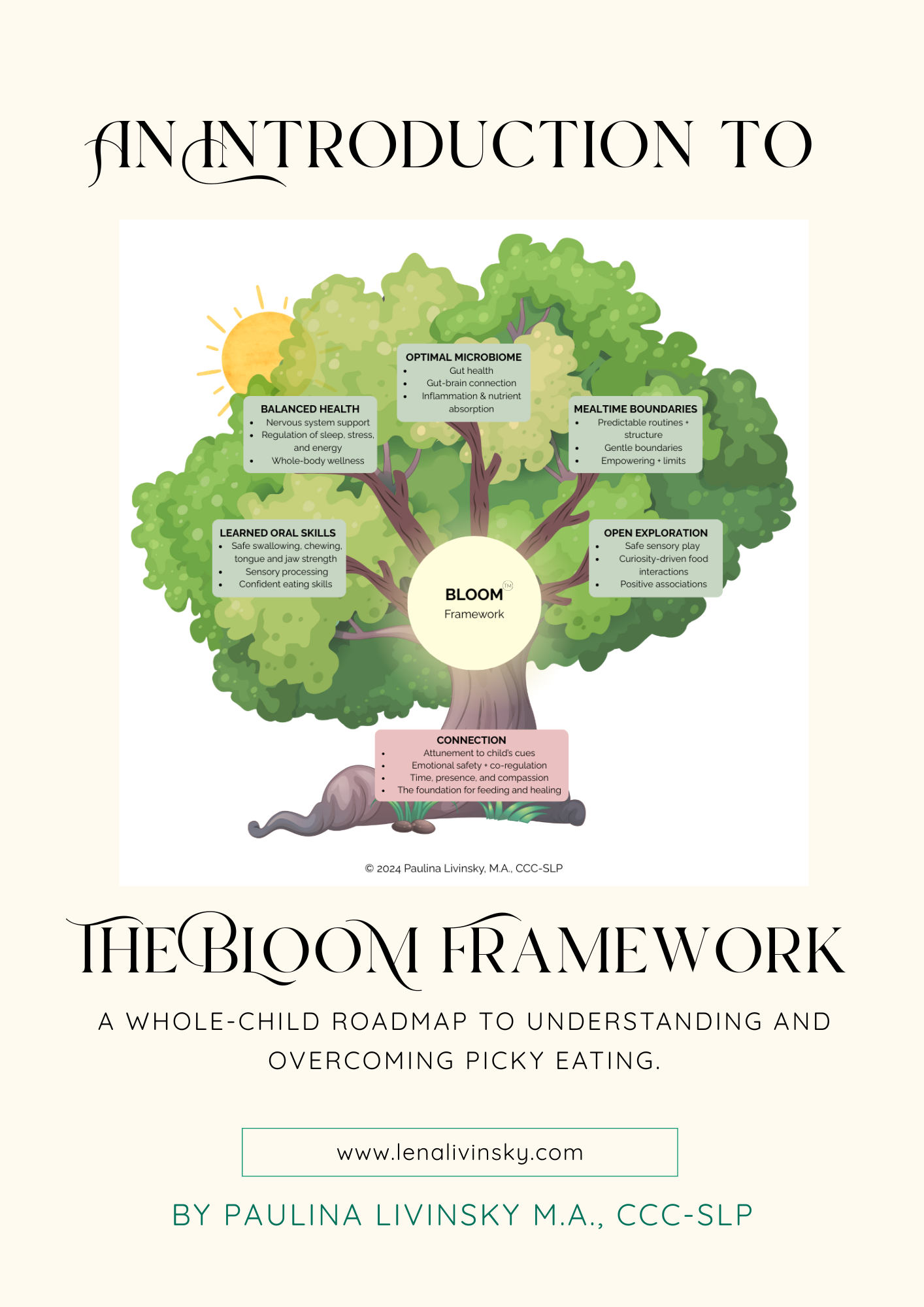
Why I created the BLOOM™ Framework
If your child refuses food no matter what you try, you’re not alone. Most parents I work with want to fix the behavior, but the truth is that the root cause of picky eating goes far deeper than what’s on the plate.
The truth is, picky eating isn’t a behavior problem, it’s a biology problem.
And until we support what’s happening inside the body, mealtimes will keep feeling hard.
That’s why I created The BLOOM™ Framework, a holistic, science-backed approach that helps families uncover the real reasons behind picky eating. Instead of fighting symptoms on the plate, we work from the inside out, balancing the body, calming the nervous system, and helping kids reconnect with food naturally.
As a pediatric speech-language pathologist, holistic feeding specialist, and mom, I’ve spent over 12 years helping children move from fear and frustration to curiosity and confidence at the table. BLOOM™ is the approach I wish every parent knew about, because it changes everything.
Ready to uncover the root cause of your child’s picky eating and finally bring peace to your family’s table?
A Fresh Perspective on the Root Cause of Picky Eating
Before we can change what happens at mealtime, we have to understand why picky eating happens in the first place. BLOOM™ helps uncover the biological, sensory, and emotional layers behind food refusal.
Why Traditional Feeding Approaches Miss the Root Cause of Picky Eating
IIf you’ve ever been told,
- “They’ll eat when they’re hungry enough.”
- “Just keep offering.”
- “It’s just a phase.”
You’ve probably already discovered those strategies don’t work. That’s because they focus only on behavior, not the root causes that drive food refusal.
Traditional feeding therapy often teaches kids how to eat, but not why their body resists food in the first place. True progress happens when we look deeper, into gut health, oral-motor skills, sensory comfort, and emotional regulation.
The BLOOM™ Framework: A Whole-Child Approach to Feeding
BLOOM™ bridges the gap between traditional feeding therapy and holistic child wellness. It helps you understand your child’s biology, behavior, and environment so you can finally support eating from the ground up.
Each letter in BLOOM™ represents one pillar of healthy feeding:
B — Balanced Health
Before food even touches the plate, your child’s body has to feel safe. We start by addressing the physical root causes of discomfort, such as:
- Digestive challenges that make eating uncomfortable
- Food sensitivities or nutrient deficiencies
- Sleep, stress, and blood sugar imbalances
A child who feels good in their body is much more open to exploring food.
L — Learned Oral Skills
This is where my background as a pediatric SLP comes in. Many children labeled as “picky eaters” actually struggle with chewing, tongue coordination, or sensory overwhelm. We support:
- Jaw strength and oral-motor skills for chewing safely
- Reducing gagging or fear around textures
- Helping sensory-sensitive kids feel safe with new foods
When eating becomes physically easier, it also becomes more enjoyable.
O — Optimal Microbiome
Your child’s gut health plays a huge role in how they eat. When the microbiome is imbalanced, appetite, digestion, and even mood can suffer. Through small nutrition shifts and gut-healing strategies, we help:
- Improve appetite and digestion
- Reduce cravings for sugar and carbs
- Support mood and attention through the gut-brain connection
O — Open Exploration
Children learn through curiosity, not control. In BLOOM™, we replace pressure with playful connection so kids can explore food without fear. This includes:
- Making food play fun and pressure-free
- Building sensory confidence through positive experiences
- Encouraging curiosity about color, texture, and taste
M — Mealtime Boundaries
This is where everything comes together. Predictable routines help kids feel safe. We create an environment where mealtime is calm, connected, and structured without pressure.
Environments that support focus and connection
Consistent meal and snack times
Clear roles: you decide what and when, your child decides if and how much
Real Results: When Feeding Heals from Within
When families start addressing the whole child, not just what’s on the plate, progress follows. I’ve seen children who ate only beige foods start exploring vibrant, nourishing meals. I’ve seen parents rediscover peace at the dinner table.
One mom told me, “I stopped bribing and started understanding and my child began eating foods I never imagined.”
That’s the power of BLOOM™: it doesn’t force change; it creates it naturally.
The Ripple Effect Beyond the Table
When we support a child’s biology, everything improves, not just eating. Parents often notice:
- Better sleep
- Fewer meltdowns
- More consistent energy
- Improved focus and mood
- Calmer, happier family mealtimes
Feeding is only one piece of your child’s development, but it’s deeply connected to every system in the body. When one area begins to heal, the rest follows.
Ready to Support Your Child’s Feeding Journey?
If you’re ready to stop guessing and start understanding, here are three ways to begin:
✨ Take the Picky Eating Root Cause Quiz – Discover what’s really driving your child’s eating struggles.
✨ Download the Calm Mealtime Toolkit – Learn my 5-step reset routine to bring peace back to your table.
✨ Join The Picky Eating Reset – A personalized program designed to help your child heal and thrive through food.
Because when we look beyond the plate, we help our children BLOOM in their body, mind, and spirit.
Ready to Address the Root Cause of Picky Eating in Your Child?
If you’re ready to uncover the root cause of your child’s picky eating and finally bring calm back to your table, I’d love to help. You can schedule a free strategy call where we’ll talk about your child’s specific feeding challenges and how the BLOOM™ Framework can help them move from stress to success.
Together, we’ll look beneath the surface, beyond the plate, to understand what’s really driving your child’s eating struggles. Whether it’s gut health, sensory sensitivities, or nervous system imbalance, there are solutions waiting for you.
Remember, mama (or dad), you’re doing an incredible job. Feeding challenges aren’t a reflection of your parenting — they’re your child’s way of communicating that something deeper needs support. And the best part? Once we address those root causes, everything begins to BLOOM.
Your family deserves a path forward that feels calm, connected, and sustainable and I’d be honored to walk it with you.


